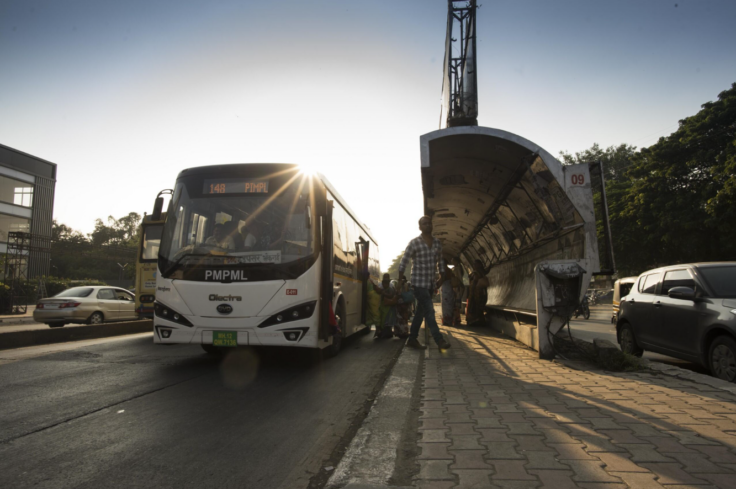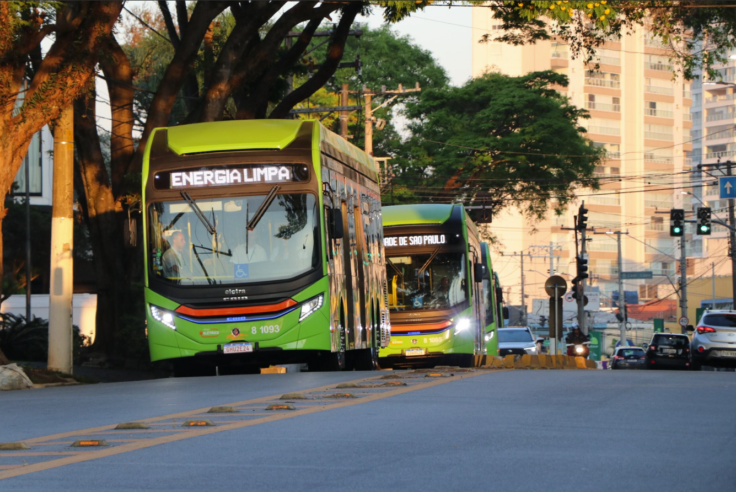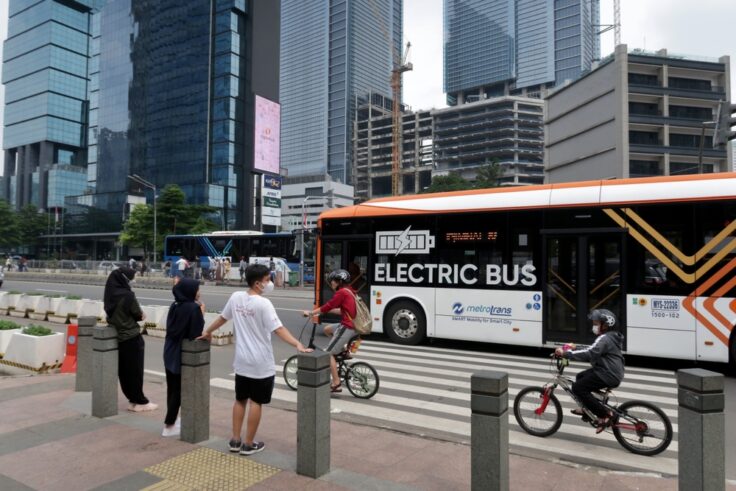January 24, 2025
E-Buses Are the Solution for Clean, Equitable Public Transport Everywhere
A version of this article was originally published in the No. 36 issue of the Sustainable Transport Magazine.
By Beatriz Rodrigues and Aimee Gauthier (ITDP Global)
All over the world, electric buses (e-buses) are becoming a cornerstone of sustainable, efficient public transport. As cities grapple with rising pollution, greenhouse gas emissions, and congestion, e-buses offer a powerful solution for the future of our transit systems. When coupled with infrastructure improvements and transit-oriented planning, e-buses pave the way for cities where more people can choose public transport over private vehicles. They are not merely a technological change; they also represent a shift towards cleaner and more reliable mobility that benefits all communities, especially those living in the Global South.
With buses accounting for more than 50% of public transport trips worldwide, electrifying urban buses at scale is a crucial move to lower emissions, boost economies, and make cities more livable. In many of the regions where ITDP works, we are seeing cities test new technologies with e-bus pilots and begin to scale their fleets with the support of new national programs that boost procurement and bring down costs. Now, public transport stakeholders must act where the rubber meets the road to ensure broader adoption from the bottom on up.
City Pilots Are the First Step
Worldwide, an estimated 635,000 e-buses are already operational as of 2023 and that number is growing. The process of deploying e-buses and charging infrastructure is one that requires strategic trial, iteration, and feedback. Pilot programs are essential for identifying challenges early on so cities can minimize the risks and adjust operational strategies to local contexts. The teams at ITDP see this transformation first-hand, having worked closely with partners in many first-mover cities on their pilots. This includes assessing the barriers — from complex geographies to inequities in access — alongside the opportunities to help inform comprehensive roadmaps for scale up. Promising evidence has emerged from pilots in cities large and small that are encouraging more national level commitments to electrification.

Latin America, for instance, is expected to have 25,000 e-buses on the road by 2030 and thus would become the largest market outside of China. ITDP is working with cities and institutions in the region to gather learnings from pilots to develop more replicable frameworks. In the city of Mérida, Mexico, e-buses were piloted on high-traffic bus routes starting in 2022. To support further expansion, the city invested in charging depots and the construction of a photovoltaic power plant to bolster energy capacity. Following the initial pilot, the city debuted an all-electric IE-Tram bus rapid transit (BRT) system in late 2023, a first-of-its-kind BRT in Mexico that is expected to serve over 25,000 users daily. In planning the system, ITDP worked with Mérida to evaluate possible corridors and identify routes for maximizing energy efficiency as the city aims to cut overall emissions by 25% by 2030.
São Paulo, Brazil launched its first e-bus pilot in 2019 following regulations that set a target for net-zero emissions from road transport over two decades. E-buses were introduced on the city’s SPTrans routes in high-traffic central and southern districts, offering vital data on charging, accessibility, and viability. The city reinforced its commitment to electrification in 2021 with a goal to deliver at least 2,600 e-buses by 2025, coinciding with a citywide wind-down on the procurement of diesel-fueled buses. While the city is currently behind on its goal due to charging and grid challenges, it is continuing to allocate substantial investments from the federal government and development banks to support more purchasing and improve infrastructure.

Across the world in South Asia, similar momentum has picked up in recent years. ITDP worked with officials in Pune, India on the city’s first e-bus pilot which launched with 150 vehicles in 2019. Primarily serving high-demand BRT corridors, the pilot allowed transport authorities to gather important insights into fleet range, depot positioning, and technical capacities. Pune’s case, along with other pilots at the time, helped the national government refine its Faster Adoption and Manufacturing of Hybrid and Electric Vehicles (FAME) incentive scheme. Following the end of its second phase, FAME’s lessons led to the announcement of more targeted e-bus incentive programs from the Indian government over the past year.
In Southeast Asia, the world’s largest BRT system (Transjakarta) in Jakarta, Indonesia reached a milestone of serving more than one million daily riders in 2020. With a surge in transit ridership, Jakarta was the first city in the country to pilot e-buses in 2019. In 2022, Transjakarta scaled its tests with 30 buses on select routes. ITDP and partners provided technical support to the city, helping analyze vehicle performance, operations, and emissions impacts in tandem with strategies for expansion. While transitioning all of Transjakarta’s buses by 2030 is a lofty target, it is also one that city and national stakeholders acknowledge is a climate imperative. In 2024, ITDP debuted an electrification roadmap with the Indonesian Ministry of Transportation to advance commitments for e-bus deployment across ten major provincial capitals.

Electrification Can Drive Economies
As city pilots provide insights into the technical challenges and opportunities, national-level policymakers are beginning to embrace the economic and investment benefits offered by e-buses. When transport networks are well-planned and efficient, they foster more transit-oriented development that spurs commercial growth, job opportunities, and green industries. Electrification demands more than just the replacement of traditional buses — it requires significant investments in shoring up infrastructure, manufacturing, operations, and energy management. Research indicates that, on average, each e-bus saves around USD $400,000 in fuel expenses and USD $125,000 in averted maintenance costs over its lifetime when compared to diesel-fueled buses.
Large-scale procurement that pools e-bus purchases across multiple cities with support from national governments can further reduce the costs to individual cities. When these savings are scaled to entire fleets, it can be to the benefit of both governments and the public alike. As more countries embrace the economic pathways for electrification, some are also committing to new financial incentives and regulatory frameworks that demonstrate top-down support. Last year in Brazil, for example, Rio de Janeiro’s mayor, governor, and the country’s President collectively announced an investment package for the city of over USD $300 million to boost the quality of the local BRT system and help procure 700 new buses. The President’s recognition of the climate and economic potential of Rio’s bus system indicates a boost for e-bus adoption across all of Brazil.
In fact, the country’s Ministry of Cities announced an investment just last year of USD $1.8 billion into fleet renewal projects in 98 municipalities that includes subsidies for over 5,300 electric and hybrid buses. In neighboring Colombia, where the capital of Bogotá is home to the region’s largest BRT, the country committed to co-financing the acquisition of 8,500 e-buses through an impressive USD $7.5 billion national fund. This fund draws on a mix of national bonds, international investments, and private financing, demonstrating a diverse approach to supporting e-bus deployment in regions where bus systems are the most essential.
Across the world, India’s PM E-Bus Sewa program is building and improving on the previous commitments of the FAME scheme. Debuted in 2023, PM E-Bus Sewa is allocating nearly USD $2.4 billion to help procure 10,000 e-buses across 169 Indian cities through a mix of public-private partnerships. This commitment is part of a national push in India to increase the share of electric vehicles on the road by focusing on public transit. And, in Indonesia this year, an analysis by ITDP presented to the Ministry of Transportation found that the implementation of 6,600 electric buses in 11 priority cities will require an investment of USD $2.5 billion by 2030. To achieve this, the Ministry is preparing an e-mobility implementation plan and a directive to advance transport electrification countrywide.
Watch ITDP’s co-hosted panel on e-buses at Climate Week NYC 2024.
A Better Vision for Public Transport
As more governments take steps to embrace e-buses, new investment channels are also growing for multi-national funds, climate financers, development banks, and many other actors to join in the movement. In tandem with the creation of new industries and jobs, the long-term direct and indirect cost savings of e-buses make them a clear solution for the future of urban transport. To successfully move from city pilots to national commitments, however, decision-makers need to prioritize strengthening policy frameworks, building financial incentives, and integrating e-buses into their larger mobility strategies. A future built around e-buses not only helps redefine the public transport experience, but is also the foundation for healthier communities, economies, and environments everywhere. As we approach the critical climate deadlines of the Paris Agreement, stakeholders at all levels must align their goals and prioritize emissions reductions within the transport sector.
As ITDP continues to build on the momentum for electrification, we know that a vision for well-managed, well-funded, and sustainable public transport is possible — and it is on the horizon.
